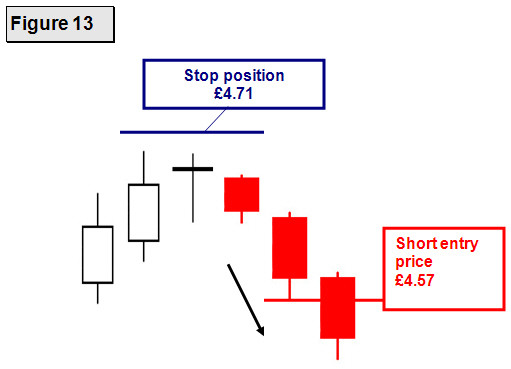The reason why you might need to do this is because you will probably be doing your analysis based on charts displaying the market price. The trade however may be based on a futures price and includes a spread. So we need to look at how to convert one to the other if you wish your order to be placed accurately. We will look at a long example in Figure 12 and just to save any confusion we will look at a short example in Figure 13.

Figure 12 shows candles or more correctly, Japanese candlesticks. The study of Japanese candlestick charts is an art in itself and there are books dedicated to this subject but if you don’t currently use them I urge you to give them a try. Like the bar chart, a candle chart allows you to see open, high, low and close prices for each day but gives you a very good visual image.
Up days are usually black lines with a white body where down days are a solid colour. The usual colours used are black, red or blue.
The body is called the “real body” and the line down the middle is called the shadow.

Refer back to Figure 12 and let’s assume that the entry is at 368 market price – this will be the price you see in your charting software – and let’s assume that you go long at a spread of 366 – 370 (you buy at 370). The spread is 4 points.
Let’s now also assume that you wish to place your stop at 359 market price. You do not need a mathematics degree to see that your stop is 9p (9 points) away from your entry in terms of market price.
You then have two options when placing your stop:
- Place a MARKET stop at 359. This will mean that if your stop is triggered because the market price (359) has been hit, the trading company will check the spread and if the spread at that time is at 357 – 361 you will be stopped out at 357 sell price. This means your loss is 370 (entry buy price) minus 357 (closing sell price), which gives a total loss of 13 points. This makes sense when you think of the market dropping 9 points and a spread of 4 points, which totals 13 points. The disadvantage of a market stop is that you could lose more points if the spread is particularly wide when your stop level is hit.
- Place a QUOTE stop. To calculate this is easy. You entered at 366 – 370. You bought (long) at 370 and if you were to sell and close the position straight away, you would have to sell at 366. BUT you want your stop to be 9 points lower so you place a stop at 366 minus 9, which gives you a quote stop at 357 (a loss of 13 points – the same as above). The disadvantage of a very tight quote stop is that you can get stopped out when you don’t want to. This can be caused by a price “spike” and the spread widening for a short while near your stop level.
“A “spike” is a sudden and instant large movement in price that usually returns to or near to the original level just as quickly. It can reflect one trade that has been done well away from the market price. If you look at a chart, spikes are represented by an abnormally long candle shadow.”
Now a Short Trade Example:

Let’s assume that the short entry is at 457 market price and the spread is 455 – 460 (you sell at 455). The spread is 5 points.
Your want your stop at 471 market price. So your stop is 14 points (14p) away from your entry. Your options are:
- Place a MARKET stop at 471. This will mean that if you get stopped out, they will look at the spread when the market price hits 471 and if the spread at that time is at 469 – 474 you will be stopped out at 474 buy price. A loss of 19 points in total (14 points move plus 5 points spread).
- Place a QUOTE stop. You sold (short) at 455 and you want your stop to be 14 points higher (at 471 market) so you place a buy stop at 460 (opening buy price) plus 14, which gives you a quote stop of 474. Again, a 19 point loss.
This trade represents a higher initial risk than the long trade example given earlier. The long example risk was 13 points where the short example risk is 19 points.
One word of warning if using a fairly tight quote stop, because the spread can increase and decrease from time to time, you must be sure to base your quote stop on the wider spread or you could be stopped out unnecessarily should the spread suddenly widen near your stop level.
Remember the earlier comment that when the market first opens in the morning the spreads can be very wide. Sometimes that wide spread can trigger your stop. Generally the spread trading companies will NOT stop you out if the only reason is an exceptionally wide market spread when the market first opens. Although the stop may trigger in the on-line system, they will not “fill” it under these conditions unless the stop has been clearly hit. They can re-set the stop once the spread settles to a more normal level.